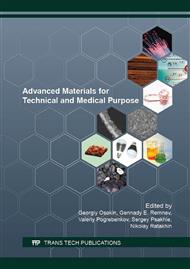[1]
Zh. Liu, Sh. Wang, J. Huang, Zh. Wei, B. Guan, J. Fang, Experimental investigation on the properties and microstructure of magnesium oxychloride cement prepared with caustic magnesiteand dolomite. Constr. and Build. Mater. 85 (2015) 247–255.
DOI: 10.1016/j.conbuildmat.2015.01.056
Google Scholar
[2]
T.F. Sweet, The Thermogravimetric Study of Hydration Products and Sulfo-Magnesia Cements, Polzunovsky Gazette. 3 (2010) 100–103.
Google Scholar
[3]
V.V. Zimich, L. Ya. Kramar, B. Ya. Trofimov, Reduced Hygroscopity and Improved Water Resistance of Chlorine Magnesia Stone by Introducing Ferric Iron, Build. Mater. 5 (2009) 58–61.
Google Scholar
[4]
V.V. Zimich, L. Ya. Kramar, T.N. Chernykh, V.N. Pudovikov, A.V. Perminov, Features of the Influence of Sol Additives of Iron Hydroxide on the Structure and Properties of Magnesia Stone, J. of the S. Ural State Univ. Ser. Constr. Archit.,. 13 (2011).
Google Scholar
[5]
V.I. Vereshchagin, V.N. Smirenskaya, S.V. Érdman, Water-resistant blended oxychlorаte cements, Glass and Ceram. 54 (1997) 368–372.
DOI: 10.1007/bf02768185
Google Scholar
[6]
V.N. Zyryanova, E.V. Lytkina, G.I. Berdov, Increased Mechanical Strength and Water Resistance of Magnesia Cement Properties with the Introduction of Mineral Fillers, Proc. High. Educ. Inst. Constr. 3 (2010) 21–26.
Google Scholar
[7]
W. F. Cole, T. Demediuk, X-Ray, thermal, and Dehydration studies on Magnesium oxychlorides, Aust. J. Chem. 8 (1955) 234–251.
DOI: 10.1071/ch9550234
Google Scholar
[8]
K.V. Gapparova, T.M. Khudyakova, V.F. Verner, L. Sh. Atanbayeva, Production of Waterproof Composite Magnesia Cement on the Basis of Local Mineral Resources. Modern Applied Science. 9, 3 (2015).
DOI: 10.5539/mas.v9n3p309
Google Scholar
[9]
M. Shand, The Chemistry and Technology of Magnesia. Hardcover, 2006, 266.
Google Scholar
[10]
V.A. Lotov, N.A. Mitina, Synthesis of Water Resistant Magnezium Cement, Techn. Technol. Silic. 3 (2010) 19-22.
Google Scholar
[11]
A.P. Smirnov, V.A. Lotov, V.A. Arkhipov, A.N. Prokhorov, I.V. Reznikov, inventors; Tomsk Polytechnic University, assignee. A technique for producing ultradispersed carbonate powders. RF patent No. 2374176. 2009 Nov 27.
Google Scholar
[12]
M. Akao, S. Iwai, The hydrogen bonding of hydromagnesite, Acta Crystallogr., Sect. B: Struct. Sci. 33 (1977) 1273–1275.
DOI: 10.1107/s0567740877005834
Google Scholar
[13]
G. Raade, Dypingite, a new hydrous basic carbonate of magnesium, from Norway. Am. Miner. 55 (1970) 1457.
Google Scholar
[14]
B. Nashar, Barringtonite – a new hydrous magnesium carbonate from Barrington Tops, New South Wales, Australia. Miner. Mag. 34 (1965) 370.
DOI: 10.1180/minmag.1965.034.268.31
Google Scholar
[15]
C. Palache, H. Berman, C. Frondel, The system of mineralogy, 7th ed., John Wiley & Sons, New York, (1944).
Google Scholar
[16]
C. Unluer, A. Al-Tabbaa, Characterization of light and heavy hydrated magnesium carbonates using thermal analysis, J. Therm. Anal. Calorim. 115 (2013) 595–607.
DOI: 10.1007/s10973-013-3300-3
Google Scholar
[17]
C. Unluer, A. Al-Tabbaa, Impact of hydrated magnesium carbonate additives on the carbonation of reactive MgO cements, Сem. And Conc. Res. 54 (2013) 87–97.
DOI: 10.1016/j.cemconres.2013.08.009
Google Scholar
[18]
P. Ballirano, C. De Vito, S. Mignardi, V. Ferrini, Phase transitions in the Mg-CO2-H2O system and the thermal decomposition of dypingite, Mg5(CO3)4(OH)2·5H2O: Implications for geosequestration of carbon dioxide. Chemical Geology 340 (2013) 59–67.
DOI: 10.1016/j.chemgeo.2012.12.005
Google Scholar


